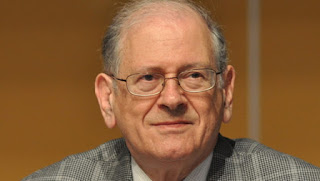Who is Bob Kahn? Biography, gossip, information?
Bob Kahn, FAQs, facts, rumors, gossip, birthday, dead, death date, birth date, net worth, gay, pregnant, drugs, weed, cocaine, smoke, sexual orientation, 2014,Vinton G. Cerf and Robert E. Kahn led the design and implementation of the Transmission manipulate Protocol and net Protocol (TCP/IP) which can be the premise for the modern-day internet. They formulated essential design standards of networking, detailed TCP/IP to fulfill these requirements, prototyped TCP/IP, and coordinated numerous early TCP/IP implementations. considering the fact that then, they have got endured to provide leadership within the networking
research community and in the emerging industries of the internet and telecommunications.
heritage
Robert Kahn was born 23 December 1938, in Brooklyn, the big apple. He earned his B.E.E. in electrical engineering on the city university of recent York in 1960 and went on to earn his M.A. (1962) and Ph.D. (1964) in electric engineering from Princeton. He took a process at AT&T Bell Labs in 1964 after which joined the electrical engineering branch at MIT as an assistant professor in 1966. Wishing to do greater applied studies, in 1967 Kahn organized a go away of absence from MIT in to paintings on the company of Bolt, Beranek and Newman (now referred to as BBN), wherein he began developing his very own thoughts for pc networking.
In 1968, Lawrence Roberts of the united states department of defense advanced studies projects enterprise issued a request for proposals for an experimental large-scale network. The ARPANET undertaking proposed the use of emerging strategies inclusive of packet switching and disbursed communications, in conjunction with an unheard-of variety of pc hardware and operating structures. The ARPANET’s backbone turned into to include a hard and fast of lengthy-distance cellphone lines connected through packet switches. BBN’s function turned into to offer the hardware and software program for those switches, called Interface Message Processors or IMPs. Kahn played a key position in system layout for the notion that in the long run received BBN the contract, and he sooner or later joined the ARPANET development team led with the aid of Frank heart.
In 1972, Kahn took the lead in organizing the primary public demonstration of the ARPANET at the October worldwide computer communication convention in Washington, D.C. prior to that demonstration the ARPANET were an exciting but underused experimental gadget however, with Kahn’s encouragement, human beings on the numerous sites began to bring new applications on-line, making the community extra attractive to customers. This effort brought the ARPANET to maturity and dramatically introduced the network to the larger computer science global.
Vint Cerf became born 23 June 1943 in New Haven, CT. He suffered from a listening to impairment from an early age, and he later attributed some of his hobby in laptop networking to its promise as an alternative communications channel for the hearing impaired. Cerf obtained his B.S. in arithmetic from Stanford college in 1965, then labored for IBM for two years, where he contributed to Quicktran, a FORTRAN primarily based time-sharing system. This whetted his hobby in laptop science, and he left IBM to take a look at at the college of California, los angeles, wherein he earned his M.S. (1970) and Ph.D. (1972) in pc science.
As a graduate student at UCLA, Cerf became involved inside the ARPANET thru Leonard Kleinrock, an expert in queuing principle who had a settlement to do performance analysis for the brand new network. As part of this role, UCLA was given one of the first 4 ARPANET nodes. Cerf became deeply involved inside the ongoing dialogue and development of the ARPANET host computer software program (NCP) via the community operating group, whose casual, decentralized mode of operation would come to be the model for net protocol development and open software program.
Joint work on the net
Cerf and Kahn first met when Kahn came to UCLA in 1969 to help take a look at the nascent ARPANET. the two fashioned an effective working relationship to generate test facts and expect and diagnose issues within the community.
In overdue 1972, Kahn joined the statistics Processing strategies office (part of the usa defense advanced research initiatives enterprise – generally called “IPTO”) as a software supervisor and initiated tasks in network safety, digital speech transmission, and packet radio. In 1973, constructing on a previous ARPA-funded task called Alohanet, Kahn initiated a ground-based packet-radio task, called PRNET, which started out experimental operation in 1975. Kahn also began experimenting with the usage of the Intelsat I satellite tv for pc to link the Arpanet to web sites in Britain and Norway (wherein ARPA carried out seismic tracking to come across Soviet underground nuclear checks). In 1975 this attempt grew into the Atlantic Packet satellite tv for pc community (SATNET), an experimental transatlantic network operated at the side of the British publish workplace and Norwegian Telecommunications Authority.
with the aid of 1973 Kahn changed into already thinking about connecting ARPA’s packet radio and satellite networks to the ARPANET, but he faced bold demanding situations, because the 3 networks had been technologically incompatible. ARPANET used point-to-point transmission, at the same time as the radio networks used broadcast; ARPANET attempted to guarantee dependable transmission of packets, even as PRNET did not; and SATNET had longer transmission delays due to the top notch distance the packets needed to tour. correctly connecting such diverse networks could require a brand new approach.
inside the spring of 1973, Kahn approached Cerf with the idea of growing a device for interconnecting networks—what might eventually be called an “internet.” Kahn felt that his very own knowledge of the hassle of connecting assorted networks, combined with Cerf’s information in writing host software, could create a strong partnership. in addition, Kahn and Cerf tested farsighted management by way of inviting networking experts from round the arena to weigh in on the internet design at a seminar in June 1973. This flow now not best brought about greater strong protocols, but also laid the basis for the worldwide unfold of the net.
Cerf and Kahn mentioned the resulting internet architecture in a seminal 1974 paper, A Protocol for Packet network Intercommunication [2].
There were key elements. First was a bunch protocol referred to as the Transmission manipulate Protocol (TCP), which turned into intended to provide reliable, ordered, drift-managed transmission of packets over the interlinked networks. 2nd become a hard and fast of gateways or routers that could take a seat between networks, passing traffic among them and handling inter-community addressing and routing. there was also a hierarchical deal with system, wherein packets have been first despatched through the gateways to a community address after which directed internally to a bunch address inside that community. The net structure became designed to make minimal needs on collaborating networks, to offer a continuing user enjoy, and to scale up gracefully, key functions that could facilitate the internet’s rapid enlargement in the Nineteen Nineties.
Cerf to start with labored on developing the net protocols as an ARPA contractor at UCLA, then moved to IPTO as application supervisor for networking in 1976, staying at the employer till 1982. In 1978 he collaborated with Jon Postel and Danny Cohen, both on the university of Southern California information Sciences Institute, to reformulate TCP as a fixed of protocols: a host protocol (TCP) and a separate internetwork protocol (IP). IP would be a stripped-down protocol for passing packets inside or between networks; it'd run on both hosts and gateways, whilst the greater complex TCP would run simplest on hosts and provide dependable give up-to-quit carrier. the new TCP/IP architecture, defined in Cerf’s 1980 article “Protocols for Interconnected Packet Networks” [3], simplified the operation of net gateways and helped growth the quantity and variety of the networks related to the internet.
Cerf and Kahn oversaw the implementation of TCP and the experimental connection of ARPANET, PRNET and SATNET in 1977; this became the first incarnation of the internet. Kahn became Director of IPTO in 1979, serving till 1985. He helped manual the changeover of ARPANET sites from the original NCP protocol to TCP/IP in 1983. additionally in 1983, Kahn initiated ARPA’s Strategic Computing Initiative, a thousand million-dollar studies program that covered chip layout, parallel laptop architectures, and artificial intelligence.
Later sports
In 1986 Kahn founded the organisation for countrywide research tasks (CNRI), where he remains Chairman, CEO, and President. CNRI is a no longer-for-earnings organization that provides technical management and finances studies and development of rising statistics infrastructure components, consisting of virtual item identifiers and “knowbots,” mobile software sellers that perform throughout networked environments.
Cerf left ARPA in 1982 to end up vp of digital records offerings at MCI, wherein he created MCI Mail. Cerf arranged for MCI Mail to turn out to be the primary commercial e-mail carrier to use the net in 1989. Cerf later returned to MCI as Senior vp from 1994-2005.
In 1986 Cerf joined Kahn as vice chairman of CNRI. In 1991, spotting the need for a impartial forum for net standards development, Cerf and Kahn based the internet Society (ISOC), an global nonprofit employer. ISOC provided an institutional domestic for the net Engineering assignment pressure, which sets technical requirements for the net, and ultimately multiplied into policy and educational sports. Cerf served as President of ISOC from 1992 until 1995. He also served as chairman of the board of the internet organization for Assigned Names and Numbers (ICANN), which coordinates the area call device among different features, from 2000-2007. In 2005 Cerf changed into hired by Google as vp and chief internet Evangelist.














